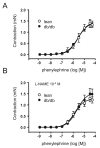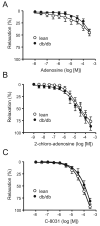Adenosine actions are preserved in corpus cavernosum from obese and type II diabetic db/db mouse
- PMID: 18221284
- PMCID: PMC3016713
- DOI: 10.1111/j.1743-6109.2007.00752.x
Adenosine actions are preserved in corpus cavernosum from obese and type II diabetic db/db mouse
Abstract
Introduction: Erectile dysfunction (ED) in diabetes is associated with autonomic neuropathy and endothelial dysfunction. Whereas the nonadrenergic-noncholinergic (NANC)/neurogenic nitric oxide pathway has received great attention in diabetes-associated ED, few studies have addressed sympathetic overactivity.
Aim: To test the hypothesis that adenosine-induced inhibition of adrenergic-mediated contractile responses in mouse corpus cavernosum is impaired in the presence of diabetes.
Methods: The db/db (obesity and type II diabetes caused by a leptin receptor mutation) mouse strain was used as a model of obesity and type II diabetes, and standard procedures were performed to evaluate functional cavernosal responses.
Main outcome measures: Increased cavernosal responses to sympathetic stimulation in db/db mice are not associated with impaired prejunctional actions of adenosine.
Results: Electrical field stimulation (EFS)-, but not phenylephrine (PE)-, induced contractions are enhanced in cavernosal strips from db/db mice in comparison with those from lean littermates. Direct effects of adenosine, 2-chloro-adenosine, A(1) receptor agonist C-8031 (N6 cyclopentyladenosine), and sodium nitroprusside are similar between the strips from lean and db/db mice, whereas relaxant responses to acetylcholine and NANC stimulation are significantly impaired in the cavernosal strips from db/db mice. 5'-Iodotubercidin (adenosine kinase inhibitor) and dipyridamole (inhibitor of adenosine transport), as well as the A(1) agonist C-8031, significantly and similarly inhibit contractions induced by stimulation of adrenergic nerves in the cavernosal strips from lean and db/db mice.
Conclusions: Results from this study suggest that corpora cavernosa from obese and diabetic db/db mice display altered neural-mediated responses that would favor penile detumescence, i.e., increased contractile response to adrenergic nerve stimulation and decreased relaxant responses upon activation of NANC nerves. However, increased cavernosal responses to adrenergic nerve stimulation are not due to impaired negative modulation of sympathetic neurotransmission by adenosine in this diabetic model.
Figures




Similar articles
-
Determination of adenosine effects and adenosine receptors in murine corpus cavernosum.J Pharmacol Exp Ther. 2007 Aug;322(2):678-85. doi: 10.1124/jpet.107.122705. Epub 2007 May 9. J Pharmacol Exp Ther. 2007. PMID: 17494861
-
Erectile dysfunction in the type II diabetic db/db mouse: impaired venoocclusion with altered cavernosal vasoreactivity and matrix.Am J Physiol Heart Circ Physiol. 2008 May;294(5):H2204-11. doi: 10.1152/ajpheart.00027.2008. Epub 2008 Mar 7. Am J Physiol Heart Circ Physiol. 2008. PMID: 18326798
-
The effect of sildenafil on corpus cavernosal smooth muscle relaxation and cyclic GMP formation in the diabetic rabbit.Eur J Pharmacol. 2001 Aug 3;425(1):57-64. doi: 10.1016/s0014-2999(01)01077-9. Eur J Pharmacol. 2001. PMID: 11672575
-
Erectile dysfunction in young non-obese type II diabetic Goto-Kakizaki rats is associated with decreased eNOS phosphorylation at Ser1177.J Sex Med. 2010 Nov;7(11):3620-34. doi: 10.1111/j.1743-6109.2010.02000.x. Epub 2010 Aug 30. J Sex Med. 2010. PMID: 20807325 Free PMC article.
-
Sympathetic Hyperactivity, Increased Tyrosine Hydroxylase and Exaggerated Corpus Cavernosum Relaxations Associated with Oxidative Stress Plays a Major Role in the Penis Dysfunction in Townes Sickle Cell Mouse.PLoS One. 2016 Dec 9;11(12):e0166291. doi: 10.1371/journal.pone.0166291. eCollection 2016. PLoS One. 2016. PMID: 27935981 Free PMC article.
Cited by
-
TNF-alpha infusion impairs corpora cavernosa reactivity.J Sex Med. 2009 Mar;6 Suppl 3(Suppl 3):311-9. doi: 10.1111/j.1743-6109.2008.01189.x. J Sex Med. 2009. PMID: 19267854 Free PMC article.
-
Alterations in the phosphodiesterase type 5 pathway and oxidative stress correlate with erectile function in spontaneously hypertensive rats.J Cell Mol Med. 2020 Dec;24(24):14280-14292. doi: 10.1111/jcmm.16045. Epub 2020 Oct 29. J Cell Mol Med. 2020. PMID: 33118708 Free PMC article.
-
Adenosine deaminase enzyme therapy prevents and reverses the heightened cavernosal relaxation in priapism.J Sex Med. 2010 Sep;7(9):3011-22. doi: 10.1111/j.1743-6109.2009.01552.x. J Sex Med. 2010. PMID: 19845544 Free PMC article.
-
GSK-3β function in bone regulates skeletal development, whole-body metabolism, and male life span.Endocrinology. 2013 Oct;154(10):3702-18. doi: 10.1210/en.2013-1155. Epub 2013 Jul 31. Endocrinology. 2013. PMID: 23904355 Free PMC article.
-
Diabetes, obesity and erectile dysfunction: field overview and research priorities.J Urol. 2009 Dec;182(6 Suppl):S45-50. doi: 10.1016/j.juro.2009.07.089. J Urol. 2009. PMID: 19846136 Free PMC article. Review.
References
-
- Sáenz de Tejada I, Angulo J, Cellek S, González-Cadavid N, Heaton J, Pickard R, Simonsen U. Pathophysiology of erectile dysfunction. J Sex Med. 2005;2:26–39. - PubMed
-
- Musicki B, Burnett AL. Endothelial dysfunction in diabetic erectile dysfunction. Int J Impot Res. 2007;19:129–38. - PubMed
-
- Morrison JFB, Pallot DJ, Sheen R, Dhanasekaran S, Mensah-Brown EPK. The effects of age and streptozotocin diabetes on the sympathetic innervation in the rat penis. Molec Cell Biochem. 2007;295:53–8. - PubMed
-
- Modan M, Halkin H. Hyperinsulinemia or increased sympathetic drive as links for obesity and hypertension. Diab Care. 1991;14:470–87. - PubMed
Publication types
MeSH terms
Substances
Grants and funding
LinkOut - more resources
Full Text Sources
Miscellaneous

